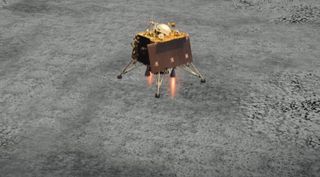India Admits Its Moon Lander Crashed, Cites Problem with Braking Thrusters
The Indian government has formally acknowledged a crash.

India has finally made it official: the country's long-silent Chandrayaan-2 moon lander Vikram did, in fact, crash into the lunar surface in September, apparently because of an issue with its braking rockets.
In newly released details about India's attempted lunar landing on Sept. 6, the Indian government has revealed that the Vikram craft "hard landed" on the moon because of a problem with its braking thrusters. Until now, the India Space Research Organisation had disclosed only that it had lost contact with the probe.
The update was announced by Jitendra Singh, the minister of state for the Department of Space, in a written response to the Lok Sabha, the lower house of India's Parliament. The news was first reported by SpaceNews.
"The first phase of descent was performed nominally from an altitude of 30 km to 7.4 km (18 miles to 4.5 miles) above the moon surface," Singh wrote, describing the lander's descent, in which the craft slowed from 5,521 feet per second (1,683 meters per second) to 479 feet per second (146 m per second).
"During the second phase of descent, the reduction in velocity was more than the designed value," he continued. "Due to this deviation, the initial conditions at the start of the fine braking phase were beyond the designed parameters. As a result, Vikram hard landed within 500 m of the designated landing site," Singh said.
Video: The Moment India Lost Contact with the Vikram Moon Lander
This is the first time that the Indian government has formally acknowledged the crash landing.
Get the Space.com Newsletter
Breaking space news, the latest updates on rocket launches, skywatching events and more!
On Sept. 10, following the loss of communication from what we now know was a crash on the moon, the ISRO announced that the "Vikram lander has been located by the orbiter of Chandrayaan-2, but no communication with it yet. All possible efforts are being made to establish communication with lander."
One explanation for why it has taken so long for the Indian government to formally recognize the crash is that, according to the ISRO, they were still trying to figure out exactly what happened. Engineers were working to reconstruct the events that led to the loss of communication with the lander and the ISRO was waiting until that work was done to make a formal announcement, S. Somanath, who directs the ISRO's Vikram Sarabhai Space Centre, said at the International Astronautical Congress (IAC) on Oct. 21, according to a statement.
However, while Somanath held off on making any formal declarations about Vikram, he did recognize that the craft most likely hit the moon so fast that it was "beyond its survivability," he said in the statement.
- India's Chandrayaan-2 Mission to the Moon in Photos
- Amazing Moon Photos from NASA's Lunar Reconnaissance Orbiter
- India's Chandrayaan-2 Spacecraft Snaps Its First Picture of the Moon
Follow Chelsea Gohd on Twitter @chelsea_gohd. Follow us on Twitter @Spacedotcom and on Facebook.

Join our Space Forums to keep talking space on the latest missions, night sky and more! And if you have a news tip, correction or comment, let us know at: community@space.com.

Chelsea “Foxanne” Gohd joined Space.com in 2018 and is now a Senior Writer, writing about everything from climate change to planetary science and human spaceflight in both articles and on-camera in videos. With a degree in Public Health and biological sciences, Chelsea has written and worked for institutions including the American Museum of Natural History, Scientific American, Discover Magazine Blog, Astronomy Magazine and Live Science. When not writing, editing or filming something space-y, Chelsea "Foxanne" Gohd is writing music and performing as Foxanne, even launching a song to space in 2021 with Inspiration4. You can follow her on Twitter @chelsea_gohd and @foxannemusic.
-
Uma Maheswar Nakka Failure is the stepping stone to success.Reply
Better luck next time and not to worry
Most Popular


